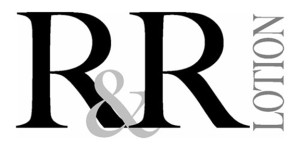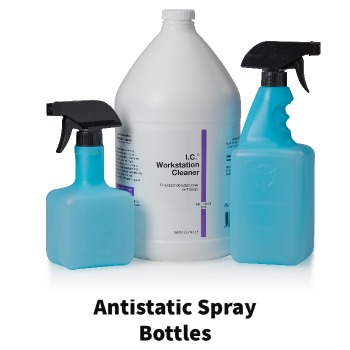Proper Surface Cleaning Procedures for Particle Removal and Static Control
Prepared By:
Jerry McCollum
Chemist
Recommended Equipment:
Static Dissipative Bottle
Due to the importance of controlling static electricity in static sensitive areas, it is recommended that all material brought into these areas be free of static charge. All conductive material should have a continuity to ground through a 1 megohm resistor and all non-conductive materials be of an Antistatic property or be handled in the flow of ionized air. The bottle that a cleaning solution is packaged in should be made of a static dissipative material with a spray pump capable of delivering an .8cc volume of fluid per stroke. This dissipative container should hold a minimum of 16 fluid ounces. The containers surface resistivity should be 10 to the 9th to 10 to the 11th ohms per square, be humidity independent, and non-greasy. The surface of the bottle should be able to dissipate a charge of + 5000 volts in less than two seconds at 40% RH.
Wiping Towel
Wiping towel should be lint free with no perfume or color. The towels should be approximately 9” to 12” square and have good absorption and non-abrasive characteristics.
Cleaning Solution
The cleaning solution should be of an appropriate solvent capable of cutting surface tension and dissolving greases for the removal of dirt and particulates from smooth and slightly textured surfaces. The solvent shall be non-flammable and non hazardous. None of the products chemicals shall be subject to SARA Title 3, Section 313 supplier notification requirements. All ingredients are either in the TSCA inventory or are not required to be listed on the TSCA inventory. The solvent, in addition to the above, should not be a controlled product under the Canadian WHIMS Regulations.
The Spray Cleaner shall contain an appropriate solvent, a non-ionic surfactant and a static neutralizing substance in a deionized water system. The static agent should leave a monomolecular film when applied to the surface to be cleaned, thus neutralizing any charge that may be present. This neutralization causes the surface to no longer attract airborne containments such as dust, lint, and other harmful particles. This monomolecular film shall be water soluble for easy removal in the event that removal is desired.
The cleaner should be streak free and biodegradable and shall contain no material known to be detrimental to an electronics/cleanroom environment. Such ingredients as Amines, Sodium, Ammonia, Bromide, Alkali or Silicone will be kept out of the cleaner formula.
R&R adheres to the stringent formulating rules mentioned above. An Ingredient List, MSDS Sheet and Samples are available to anyone needing that information.
How to Use
Fold wiper in half and then in half again exposing ¼ of the total wiping surface. Holding the sprayer 12” to 18” away from the surface to be cleaned, pull the trigger to dispense a quantity sufficient to cover the area with a thin layer of cleaner. Avoid over spraying or soaking the area. Under most circumstances this will be 1 to 4 pulls on the trigger which will dispense approximately 3.2 cc of fluid per meter. For heavily soiled surfaces, repeat cleaning steps rather than using excessive cleaning solution. Immediately begin wiping surface. Start at point furthest away from cleaning position and begin wiping in one direction, either left to right or right to left. Wipe in chosen direction only once then unfold or turn wiper to expose clean surface and continue wiping one path below the path previously wiped. Wiping should always be done in the same direction. Continue to wipe until entire surface is clean and dry.
After top surfaces have been cleaned, wipe edges and corners in a continuous motion taking care to wipe thoroughly and dry. Follow the same method of using a dry clean wiper surface and wipe in one direction only.







